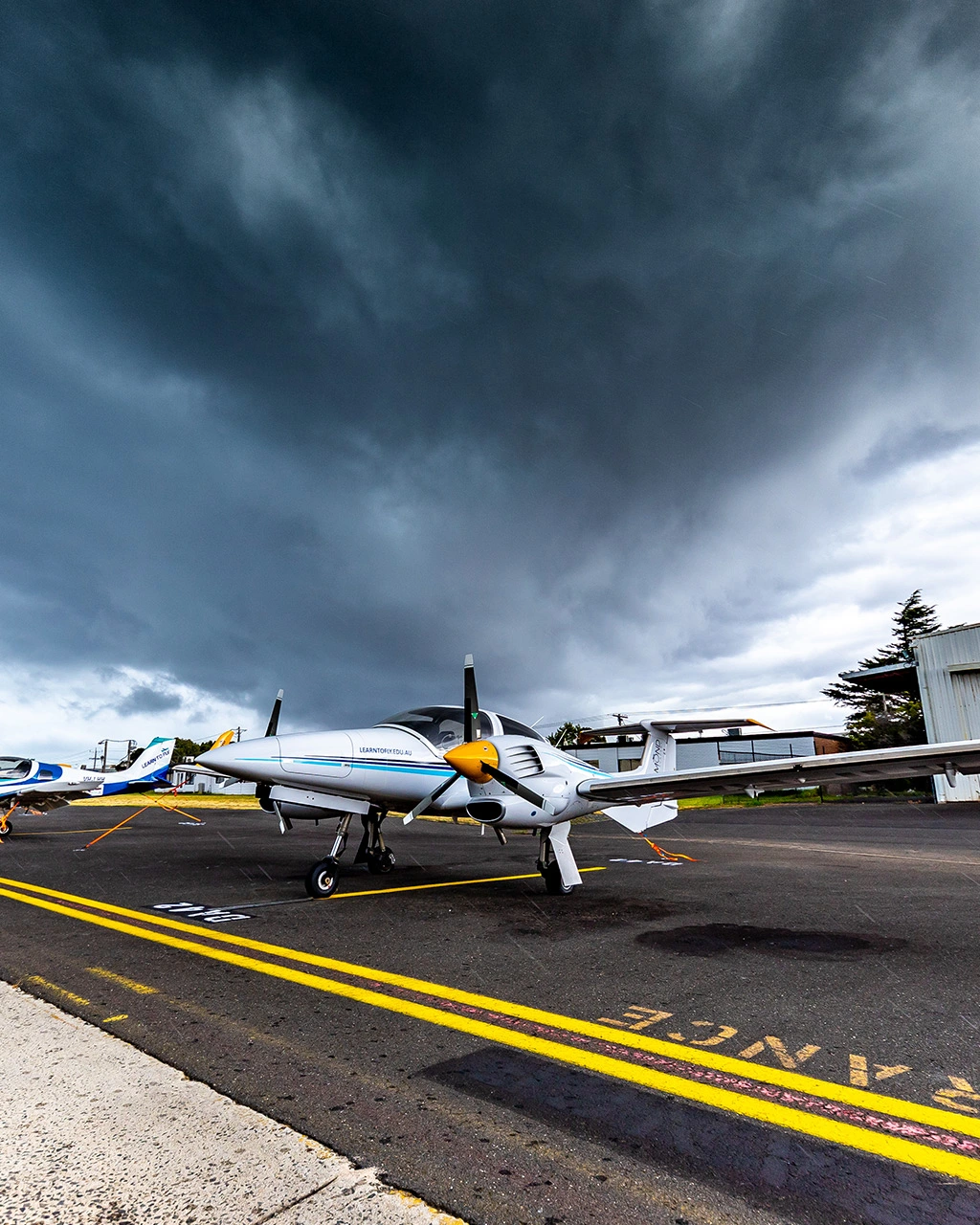
June 21, 2024
Weather briefings and decision-making: Safely navigating weather conditions
Weather plays a critical role in aviation safety, influencing flight operations at every stage from pre-flight planning to post-flight debriefing.
When learning how to become a pilot in Australia, aspiring pilots must develop a thorough understanding of weather phenomena and access to reliable weather information to make informed decisions and mitigate risks.
Weather briefings and decision-making strategies ensure the safe navigating of weather conditions throughout all phases of flight.
Types of weather briefings
Weather briefings ensure pilots have a comprehensive understanding of weather dynamics and its potential impact on a flight’s safety.
Pre-flight briefings, conducted before departure equips pilots with an overview of anticipated weather conditions along the intended flight route. These briefings encompass crucial elements such as wind patterns, visibility, and the presence of significant weather phenomena like thunderstorms, icing conditions, low cloud coverage, fog and precipitation. With this information, pilots can make decisions regarding route selection, altitude adjustments, additional fuel for holding and potential diversions.
In-flight briefings are equally vital, providing pilots with real-time updates on weather developments during the flight. This enables pilots to adapt swiftly to changing weather patterns, mitigate risks, and ensure the safety of passengers and crew. Pilots request updates on weather changes, including the formation of convective weather systems, deteriorating visibility, or unexpected turbulence, allowing them to modify flight plans accordingly.
Post-flight briefings offer pilots the opportunity to reflect on weather conditions encountered during the flight and evaluate the effectiveness of their decision-making process. By reviewing actual weather data and comparing it to forecasts, pilots can identify areas of improvement and refine their strategies for future flights. This retrospective analysis is crucial for enhancing situational awareness, honing decision-making skills, and promoting continuous learning and improvement in aviation safety.
Understanding weather hazards
Aspiring pilots must learn and understand the different weather hazards that can occur to mitigate risks and ensure the safety of flight operations effectively.
Thunderstorms are capable of producing severe turbulence, lightning strikes, and hail. These hazardous conditions can threaten the aircraft’s structural integrity and lead to in-flight emergencies if encountered. Pilots must exercise caution and avoid thunderstorm cells to prevent potential accidents.
Turbulence, whether associated with convective weather systems or occurring in clear air, can cause discomfort for passengers and crew and may result in structural damage. Pilots must anticipate turbulence and take appropriate measures to minimise its impact on the aircraft’s stability and safety.
Icing is another hazardous weather phenomenon encountered during flight, particularly in colder climates or at higher altitudes. Ice accumulation on aircraft surfaces can disrupt airflow, impairing aerodynamics and increasing stall speed. Pilots must be vigilant in identifying icing conditions and employ de-icing or anti-icing systems to mitigate its effects.
Fog presents visibility challenges, reducing visual navigation capabilities and necessitating reliance on instrument flight procedures. Pilots must exercise caution when operating in foggy conditions, maintaining proper situational awareness and adherence to diverting or holding instructions to ensure safe navigation and landing.
Weather decision making
When learning to become a pilot, aspiring pilots are taught about the critical importance of weather decision-making in aviation safety. This process requires pilots to assess and respond to weather-related risks with prudence and foresight.
Pilots must carefully evaluate forecasted weather conditions, taking into account factors such as wind speed and direction, visibility, and the presence of convective weather systems. By analysing weather data from reliable sources and consulting with meteorologists when necessary, pilots can develop a comprehensive understanding of the atmospheric conditions they may encounter during flight.
Personal minimums should also be a part of weather decision-making, as pilots must establish thresholds for weather conditions beyond which they are unwilling to fly. By adhering to personal minimums, pilots can mitigate risks and prioritise safety over schedule pressures or other external factors.
Flexibility and adaptability are essential traits for pilots to modify flight plans or divert to alternate airports as needed in response to changing weather conditions. By remaining vigilant and responsive to weather-related challenges, pilots can make informed decisions to ensure the safety of flight operations.
Weather briefing procedures in flight schools
Weather briefing procedures are an integral part of a pilot course in Australia, ensuring that aspiring pilots are well-equipped to avoid and manage various atmospheric conditions. The training typically begins with an introduction to different types of weather briefings, including pre-flight, in-flight, and post-flight briefings. Students learn to access and interpret critical weather information from reliable sources such as METARs, TAFs, GAFs, weather radar, cams and satellite imagery.
Flight instructors emphasise the importance of pre-flight briefings, guiding students through the process of reviewing weather charts, and NOTAMs to gain a comprehensive understanding of current and forecasted weather along their planned routes. Requesting in-flight weather briefings are also covered, teaching students how to obtain real-time updates and adjust their flight plans as necessary. Post-flight briefings are used to review and analyse the weather encountered during the flight.
Curriculums also include practical exercises and simulations where students apply these procedures in real-world scenarios. This hands-on approach ensures that they develop the skills needed to assess weather conditions effectively and make decisions. By the end of their training, student pilots are proficient in utilising various weather briefing tools and technologies, enabling them to navigate weather-related challenges safely and efficiently.
Weather briefings and decision-making strategies are essential for pilots to safely navigate weather conditions and ensure the safety of flight operations. By understanding different types of weather briefings, accessing reliable weather information, and employing effective decision-making techniques, pilots can mitigate weather-related risks and maintain a high standard of safety in aviation.








